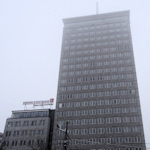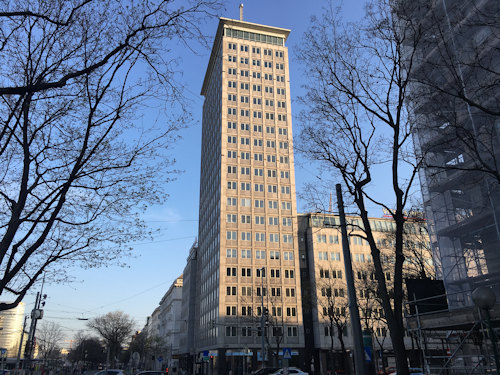
One of the activities of the Vienna Insurance Group is insuring buildings, another is showcasing them. All thanks to the Architektur im Ringturm public exhibition space in their Vienna headquarters.
- Ongoing series of exhibitions on (mainly) architecture
- Hosted in a historical office tower
- Entry is normally free
- Current/next exhibition:
- Top examples of energy-saving building projects (April 10th to June 7th, 2024)
- See also:
Public exhibitions

(The Ringturm building; office and exhibition venue)
The late 1990s saw the hall that once housed the public counter area for the insurance company converted into a professional exhibition space. Since then, the Ringturm has hosted a series of exhibitions under the title Architektur im Ringturm.
The building’s owners and occupiers (Vienna Insurance Group) are quite invested in giving back through sponsorship of art and cultural events. They also have their own extensive art collections, with highlights on show at the Leopold Museum in summer 2024.
The Ringturm’s façade often converts into a giant piece of artwork in its own right. And the giant Christmas lights display has become a traditional part of the Viennese festive season.
Most of the exhibitions within highlight architectural themes or architects from around the world, though the emphasis tends to be on those countries where the company is active commercially: mostly central and eastern Europe.
For example, an earlier exhibition used nine Viennese buildings to illustrate the sociopolitical impact of architecture over the past 100 years of Austrian history. Another featured architectural developments in Vienna and Budapest after the break up of the Austro-Hungarian monarchy.
Find details of current and past Ringturm exhibitions at the dedicated website, but here’s an overview of the most recent ones…
Current/next exhibition
- Das neue Bauen (my translation: The New Building): presents 50 top examples of building projects that provide energy-saving environments, whether as new constructions, repurposed locations or renovations. The focus is on buildings that are energy neutral or produce more energy than they consume (April 10th to June 7th, 2024)
Selected past exhibitions
Bauherrenpreis 2023
A regular look at the winners and contenders for this architectural prize. The exhibition focused on the three 2023 winners, but also featured projects that made it onto the shortlist and the five winners from the 2022 edition.
Anti-violence
A special exhibition in cooperation with the Orange the World campaign of the UN Women and part of the Vienna Insurance Group’s own wider campaign against violence. The exhibition tackled issues around situational and domestic violence and the role of art and safe public spaces in awareness and prevention.
Slovenia: Discovery Tour – Plečnik and His Timeless Language of Forms
A journey around the works of the remarkable Jože Plečnik, who left his mark on Slovenian architecture in the first half of the 20th century.
Excellent Environments
Another appearance for the prestigious Bauherrenpreis architectural awards, this time with the 24 projects that made it onto the 2021 shortlist.
The exhibition had a special focus on the six winners: school and education centres, a chapel, a viewing platform, a museum, and a social housing complex.
István Medgyaszay – Hungarian Modernist Architect
István Medgyaszay (1877 – 1959) counts as one of the fathers of Hungarian modernism and was a former student of the great Viennese architect, Otto Wagner.
Campus of Religions – interreligious meeting place
Featured the designs submitted for the new interfaith centre in Vienna, with a special focus on the Burtscher-Durig design that will actually be used for the college and religious buildings.
Over 40 firms from around Europe competed in this urban planning competition.
Boris Podrecca – Architecture
Belgrade-born Podrecca counts as one of Europe’s more renowned architects and the Vienna resident has already influenced the city skyline here (he co-designed the huge Millennium Tower in the 20th district).
The exhibition used models and accompanying text and literature to showcase Podrecca’s more recent work. He even designed the exhibition space himself.
Excellent Environments
A presentation of the projects shortlisted for the 2019 Austrian Builder-Owner Award (the Bauherrenpreis), with prominence given to the six actual award winners.
These winners included cattle accommodation, a private house, a school and the University of Applied Arts Vienna.
Albania – Decades of Architecture in Political Context
Architecture is a relatively young discipline in Albania, but has blossomed following the demise of the communist regime in the early 1990s.
Curated by Adolph Stiller in cooperation with Tirana’s Polis University, the exhibition presented some of the jewels of Albanian architecture from the past 100 years or so.
Stefka Georgieva
Curated by Aneta Bulant-Kamenova and Adolph Stiller, the exhibition celebrated the work of Bulgarian architect, Stefka Georgieva, particularly the buildings and projects she designed.
Georgieva’s most significant works appeared in the 1960s and 1970s in Sofia, Varna, and elsewhere in her home country. She received many national and international accolades during her life, including a prestigious Herder Prize (awarded in 1981).
Mario Botta – Sacral Spaces
The Sacral Spaces exhibition showcased Mario Botta’s building designs for religious settings. The Swiss architect has a long list of outstanding works to his name, including the Museum of Modern Art in San Francisco and the National Bank of Greece.
His religious buildings include such eyecatching designs as the Santa Maria degli Angeli chapel in Switzerland, Évry Cathedral in France, or the Cymbalista Synagoge in Israel.
Ausgezeichnete Lebensräume
This exhibition put the spotlight on the nominees that made the final shortlist for the 2018 Austrian Bauherrenpreis, a prestigious award given for construction works, landscape architecture and urban solutions. The six eventual winners were given special emphasis.
One of the award winners was actually from Vienna: a school centre on the outskirts in Aspern (a location famous for being the site of the first battle that Napoleon ever lost).
Zwischen Kaukasus und Schwarzem Meer
This exhibition examined the architectural landscape across Georgia, a country spanning a breadth of geographical and cultural influences: Russia and a Soviet past on one side, Turkey and Asia on the other; the Caucasus mountains to the north and south, the Black Sea to the west.
Tickets & visitor tips
When an exhibition takes place, entry is usually free.
Another place in Vienna for those with an architectural bent is the AZW (Architekturzentrum Wien): the country’s only museum dedicated to the topic with a small-but-lovely permanent exhibition and regular temporary ones.
How to get to the Ringturm
As the name suggests, the Ringturm is on the Ring boulevard that encircles most of the city centre, albeit on the side opposite to most of the tourist attractions.
It’s easy to reach, being next door to the Schottenring station, which is fed by the U2 and U4 subway lines, the 1 and 31 tram, and bus 3A. Or you can just walk to it from the city centre.
Address: Schottenring 30, 1010 Vienna